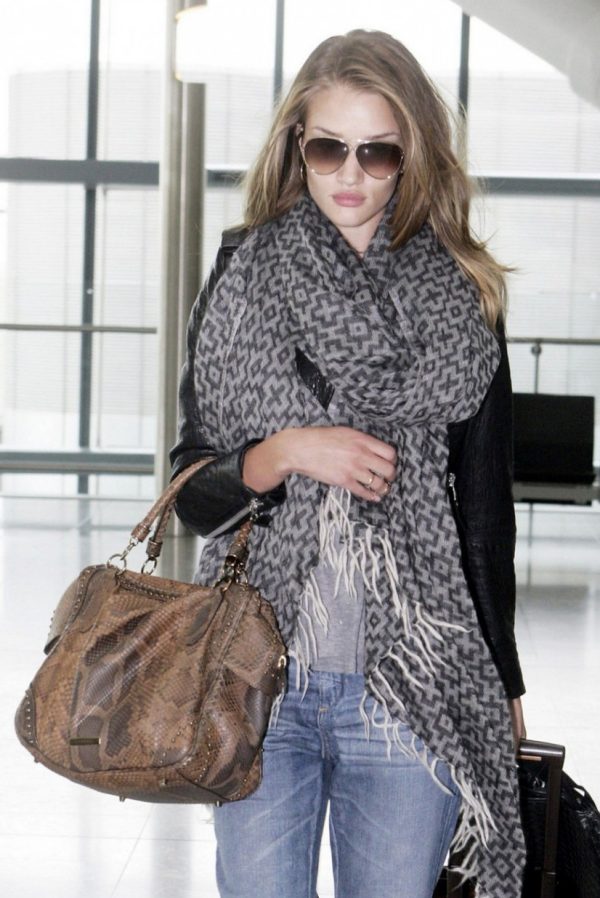Why Wear A Scarf When Flying - Benefits And Tips
When it comes to air travel, comfort and style are two key factors that travelers often consider. One accessory that has gained popularity among frequent flyers is the scarf. You might wonder, why wear a scarf when flying?
Author:Jane RestureJun 04, 202310.6K Shares281.1K Views

When it comes to air travel, comfort and style are two key factors that travelers often consider. One accessory that has gained popularity among frequent flyers is the scarf. You might wonder, why wear a scarf when flying?
The truth is, a scarf offers numerous benefits that make it an essential item for your journey. Not only does it provide warmth and comfort in chilly airplane cabins, but it also adds a touch of style and versatility to your travel attire.
In this article, we will explore the reasons why wearing a scarf when flying is a smart choice and how it can enhance your overall travel experience. So, let's unravel the secrets behind this practical and fashionable travel companion.
Reasons Why Wear A Scarf When Flying
travel a scarf if you want to travel light while yet appearing stylish. A scarf provides the most adaptability since it takes up minimal baggage space while adding to your fundamental travel clothing selections. Scarves may add a splash of color, pattern, or texture to an otherwise bland travel clothing.
Here are some more reasons to bring a scarf:
- If you go to Europe I don't believe you'll be let in unless you're wearing one. Of course, I'm joking, but it's fantastic to see almost everyone wearing a scarf. It is essential to wear one if you wish to blend in.
- Thin and lightweight scarves take up less packing room and may offer that certain something that we all seek. Different designs and sizes may be worn in a variety of ways to fit your own style.
- A scarf will give you the star jetsetter appearance. Just be cautious since you may have to fight off cameras when you arrive! While we may not look like Rosie Huntington-Whitely, we may simply replicate her appearance by adding an enormous scarf to our travel day suit.
- We've all heard the suggestion to bring a pashmina-style shawl for airline, train, or bus travel, but it bears repeating. A huge wrap scarf can keep you warm on frigid aircraft rides, and more layers will help you get through lengthy travel days.
- Carry a scarf with you to venues where modest attire is necessary, such as European churches or Asian temples. Many places of worship demand you to cover your shoulders or do not allow you to wear shorts. Wrap a scarf over your shoulders or use it as a pareo wrap to cover off your legs if you're wearing shorts.
- If you're traveling with others, a bright scarf might assist you maintain track of your companions. It may seem stupid, yet it is useful in crowded marketplaces.
- If you truly want to fit in, acquire a scarf when you get at your location. This might provide an occasion to do some shopping and visit local shops or street markets. I normally purchase one to use for the length of my vacation and enjoy having a one-of-a-kind remembrance of my travels long after my trip has ended.
- A bigger scarf may be used as a swimming suit coverup or towel.
- A little silk scarf will assist tame your mane if you've been on an overnight train or a lengthy aircraft ride and have a nasty case of bedhead.
- If you use perfume, there's no need to bring it with you. Simply spray your scarf with your favorite fragrance (like a French lady would). It will keep your baggage smelling nice, and when you wear your scarf, you will notice a mild perfume.
- For all my other moms out there, my kids often utilize my scarf as an additional blanket and sometimes as an impromptu tissue. I know that's not very fashionable and sort of nasty, but it comes in useful.
- Instead of using a travel cushion, coil up your scarf and use it as additional neck support during a lengthy journey.
Benefits Of Wearing A Scarf When Flying
Warmth And Coziness
- Insulation- Scarves provide an extra layer of warmth to keep you comfortable during the flight, especially in colder cabins or during long-haul journeys.
- Adjustable Coverage- You can adjust the scarf to cover your neck, shoulders, and even your face, providing customized warmth based on your preferences.
Versatility And Style
- Fashionable Accessory- Scarves come in various colors, patterns, and styles, allowing you to add a touch of personal style to your travel outfit.
- Easy to Pack- Scarves are lightweight and foldable, making them convenient to pack in your carry-on luggage without taking up much space.
Protection From Airplane Germs
- Barrier from Germs- Scarves act as a physical barrier between you and potentially germ-ridden surfaces, such as airplane seats, tray tables, and armrests.
- Reduced Exposure- By covering your nose and mouth with a scarf, you can minimize direct contact with airborne particles and reduce the risk of inhaling germs.
Comfort And Relaxation
- Neck and Shoulder Support- Wrapping a scarf around your neck can provide support and alleviate tension in the neck and shoulder area during the flight.
- Cozy Blanket Substitute- In case the airplane blankets are not available or not to your liking, a soft and lightweight scarf can serve as a substitute for added comfort and relaxation.
Privacy And Security
- Modesty and Privacy- You can use a scarf to cover your head or hair for added privacy, modesty, or cultural reasons, ensuring your personal comfort and beliefs are respected during the flight.
- Security for Valuables- Tying a scarf around your bag or purse can provide an extra layer of security by keeping the contents concealed and preventing unauthorized access.
Practical Uses Of A Scarf During A Flight
Pillow Or Neck Support
- Rolled-up Scarf- Roll your scarf into a comfortable shape and use it as a pillow to support your neck or provide cushioning for your lower back.
- Folded Scarf- Fold your scarf and place it behind your neck for added support and to prevent stiffness during long flights.
Eye Mask Or Sleep Aid
- Coverage for Restful Sleep- If you prefer darkness while sleeping, you can cover your eyes with a scarf to block out light and create a more conducive environment for rest.
- Soft and Gentle Fabric- Scarves made from lightweight and breathable materials can provide a soothing sensation on your face, enhancing relaxation and promoting sleep.
In-flight Entertainment And Comfort
- Blanket Substitute- Scarves can serve as a lightweight and versatile alternative to the provided airplane blankets, offering warmth and comfort during the flight.
- Privacy Shield- Use a scarf to create a barrier or partition between you and neighboring passengers, providing a sense of personal space and privacy.
Fashionable Accessory And Style Enhancer
- Layering and Style Statement- Scarves can add a pop of color or texture to your travel attire, elevating your fashion game while staying cozy during the flight.
- Versatile Styling- Experiment with different scarf tying techniques, such as knots or drapes, to create unique looks and express your personal style.
Emergency Preparedness
- Face Covering- In situations where you may encounter dusty or smoky conditions during the flight, a scarf can be used as a makeshift face covering to provide temporary protection.
- Bandage or Tourniquet- In case of a minor injury, a clean scarf can be used as an improvised bandage or tourniquet to provide initial first aid until professional help is available.
Tips For Choosing The Right Scarf For Travel
Material And Fabric
- Lightweight and Breathable- Opt for scarves made from materials like cotton, linen, or silk that are breathable and suitable for various climates.
- Wrinkle-Resistant- Choose fabrics that are less prone to wrinkling, making it easier to pack and ensuring your scarf looks fresh during your travels.
Size And Length
- Versatility- Select a scarf that is long enough to be worn in multiple ways, such as wrapping it around your neck, using it as a shawl, or transforming it into a headscarf.
- Compactness- Consider scarves that can be folded or rolled up easily without taking up too much space in your carry-on luggage or travel bag.
Color And Pattern
- Versatile Neutrals- Opt for neutral-colored scarves, such as black, gray, or beige, which can effortlessly complement different outfits and travel ensembles.
- Statement Pieces - If you want to add a touch of personality to your travel attire, choose scarves with vibrant colors or interesting patterns that reflect your style.
Functionality
- Weather Adaptability- Consider the climate of your destination and choose scarves that can provide warmth in colder regions or offer lightweight coverage in warmer areas.
- Multi-Purpose Features- Look for scarves with added functionalities, such as built-in pockets or hidden compartments, which can be useful for storing small travel essentials like keys, cards, or headphones.
Easy Maintenance
- Machine Washable- Opt for scarves that are machine washable or easy to clean, ensuring convenient maintenance during your travels.
- Quick-Drying- If you plan to wash your scarf while on the go, choose materials that dry quickly, allowing you to reuse it without waiting for extended drying times.
How To Wear A Scarf In Different Ways While Traveling
Classic Neck Wrap
- Start by folding the scarf in half to create a loop.
- Place the loop around your neck, with the loose ends hanging down in front.
- Take the loose ends and thread them through the loop, adjusting the tightness and position to your comfort.
Shawl Or Wrap
- Open up the scarf and drape it over your shoulders like a shawl.
- Adjust the scarf to cover your arms and upper body, providing extra warmth during flights or chilly evenings.
- You can secure it with a pin or brooch for added style and to keep it in place.
Headscarf Or Headband
- Fold the scarf into a thin, long strip.
- Place the scarf over your head, with the middle part resting on your forehead.
- Take the ends of the scarf and tie them at the nape of your neck, creating a headband look.
- Alternatively, you can wrap the scarf around your head and tie it at the back for a chic and practical headscarf style.
Belt Or Waist Wrap
- Fold the scarf into a narrower band or use a thinner scarf.
- Wrap the scarf around your waist and tie it securely.
- This creates a stylish belt that can cinch in loose-fitting dresses or tops, adding definition to your outfit.
Bag Accessory
- Attach the scarf to your handbag or carry-on luggage for a pop of color and personal style.
- You can tie it around the handle, knot it through a loop, or wrap it around the bag itself.
- This not only adds a decorative touch but also makes your bag easier to spot in crowded places.
Face Covering Or Mask
- In situations where face coverings or masks are required, you can use a scarf as an alternative.
- Fold the scarf diagonally to create a triangle.
- Place the folded scarf over your nose and mouth, with the ends tied securely behind your head.
- Ensure it covers your nose, mouth, and chin adequately for protection.

4 Ways to Wear a Scarf while Travelling | Singapore Airlines
People Also Ask
Can Wearing A Scarf Help With Comfort During Flights?
Wearing a scarf can provide added comfort during flights by providing warmth and acting as a cozy accessory.
Does Wearing A Scarf Help Prevent Dehydration While Flying?
While a scarf itself may not directly prevent dehydration, it can help by keeping the neck area covered and preventing moisture loss from the skin.
Are Scarves Useful For Protecting Against Germs On Airplanes?
Scarves can act as a barrier between your face and potential germs on airplanes, providing an extra layer of protection.
Can Wearing A Scarf Help Regulate Body Temperature During Flights?
Yes, wearing a scarf can help regulate body temperature during flights by providing insulation in cooler environments or allowing for easy adjustment in warmer conditions.
Are There Any Fashion Benefits To Wearing A Scarf When Flying?
Absolutely! Wearing a scarf adds a stylish touch to your travel outfit, allowing you to showcase your personal style while staying comfortable during the flight.
Final Thoughts
Why wear a scarf when flying? is a practical and versatile choice for travelers. Not only does it provide warmth and protection from fluctuating cabin temperatures, but it also serves as a fashionable accessory that adds style to your travel ensemble.
Whether you prefer a cozy cashmere scarf or a lightweight silk one, the options are endless when it comes to finding the perfect scarf for your flight.
So, next time you embark on a journey, don't forget to bring along a scarf and enjoy the comfort, style, and functionality it brings to your travel experience. Happy flying!

Jane Resture
Author
Since she embarked on her first world trip in 2002, Jane Resture spent the past decades sharing her personal journey and travel tips with people around the world. She has traveled to over 80 countries and territories, where she experienced other cultures, wildlife she had only read about in books, new foods, new people, and new amazing experiences.
Jane believes that travel is for everyone and it helps us learn about ourselves and the world around us. Her goal is to help more people from more backgrounds experience the joy of exploration because she trusts that travel opens the door to the greatest, most unforgettable experiences life can offer and this builds a kinder, more inclusive, more open-minded world.
Latest Articles
Popular Articles